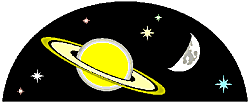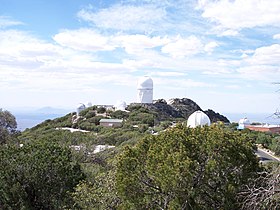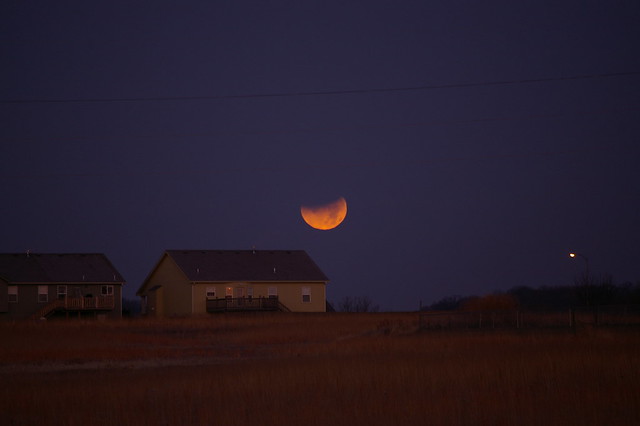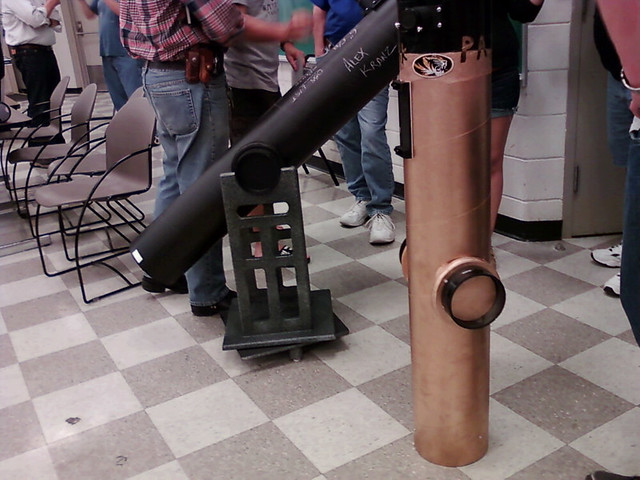 I missed the dawn of International Astronomy Day, thanks to a mostly overcast sky here in the Heart of America. By mid-morning, the skies had partially cleared to allow the sun to peak through occasionally during my morning long walk with Apollo. But by late afternoon, the clouds had crept back in to conspire against any star, planet or moon gazing. Never admitting defeat, though, my dad and I headed to Kansas City to attend the April general meeting of the Astronomical Society of Kansas City (ASKC).
I missed the dawn of International Astronomy Day, thanks to a mostly overcast sky here in the Heart of America. By mid-morning, the skies had partially cleared to allow the sun to peak through occasionally during my morning long walk with Apollo. But by late afternoon, the clouds had crept back in to conspire against any star, planet or moon gazing. Never admitting defeat, though, my dad and I headed to Kansas City to attend the April general meeting of the Astronomical Society of Kansas City (ASKC).

Due to student examinations, our normal meeting place, a lecture hall in Royal Hall on the campus of UMKC, wouldn’t be available until 7:30 p.m (instead of our normal seven o’clock start time). Many members arrived early and congregated in the hallway outside. I met my team leader and we exchanged business cards. In May, I have my first night assisting at a Powell Observatory public night as a ‘staff’ member. My team leader, though, won’t be with us that weekend, as she’s traveling to Arizona to observe, first hand, the solar eclipse that occurs across the Southwest on Sunday, May 20th. She did introduce me to her backup leader for Team 2, who also happens to be a resident of a town very close to where I live now. Always good to know who has been bitten by the astronomy bug in your local neighborhood.

The room became available about ten minutes before half past seven and I relocated from the hallway to seating in the lecture hall. I kicked myself for not bringing my notepad with me to take notes during the meeting. Yes, I could have used my Nook Color (by pretending to send an e-mail I could have typed up notes), but not having a ‘real’ keyboard would slow me down too much. The same guy who I had just met as my backup team leader just happened to be the Vice President and began the meeting mostly on time. He announced our illustrious president was absent this evening and bearing the heavy cross of observing from Kitt Peak. We all groaned appropriately, most of us with envy.
 The meeting continued with Master Observer Scott Kranz handing out Astronomical League observing awards to several club members. The Astronomical League is an umbrella organization composed of over two hundred and forty local amateur astronomical societies from all across the United States and forms one of the largest amateur astronomical organizations in the world. Many of the certificates and pins awarded during the meeting resulted from the late March Messier Marathon, including one club member who found 109 of 110 Messier objects during one night of observing. A similar award based on a detailed analysis and observation of all 110 Messier objects, albeit not in one night, was also awarded to Steve King, the club’s observatory director.
The meeting continued with Master Observer Scott Kranz handing out Astronomical League observing awards to several club members. The Astronomical League is an umbrella organization composed of over two hundred and forty local amateur astronomical societies from all across the United States and forms one of the largest amateur astronomical organizations in the world. Many of the certificates and pins awarded during the meeting resulted from the late March Messier Marathon, including one club member who found 109 of 110 Messier objects during one night of observing. A similar award based on a detailed analysis and observation of all 110 Messier objects, albeit not in one night, was also awarded to Steve King, the club’s observatory director.
Scott encouraged all of us to look through the list of observing projects after the meeting. I still need to finish the one I grabbed last year (about this time) called the Astro Quest General Observing Award. In reviewing the list of objects available in that Quest, I have observed several of them already, and even have photograph evidence of same (and blog posts here) as further proof. Now I’m even more pumped up to attend next month’s club star party so I can check off a few more from the Quest list.

The second item on the agenda included education and announcements presented by Jay Manifold. He covered the night skies for the opening public nights at the Warko and Powell observatories, one of which includes the largest full moon of the year, on May 5th. He also mentioned the solar eclipse on May 20th, which we won’t be able to see much of here in Kansas or Missouri. He asked for members to submit photographs of the lunar eclipse on June 4th and I plan to put that on my calendar to repeat what I did back in December 2011.
 The Transit of Venus again topped everyone’s list for ‘must see’ observations this year. I’m praying for clear skies on June 5th. Or I might be driving fast to the nearest clear skies so I can observe Venus transit across the face of the Sun … truly a once-in-a-lifetime opportunity. I doubt I’ll be around for the next one in 2117. To that end, I acquired (finally) some solar film thanks to a couple of club members. I left it in my father’s good hands (since he has my telescope for the foreseeable future … at least until after my daughter graduates from college in mid-May). Now we can make some filters to go over the scope, camera lenses and binoculars and we’ve still got time to practice solar observing before the actual Transit of Venus occurs in early June.
The Transit of Venus again topped everyone’s list for ‘must see’ observations this year. I’m praying for clear skies on June 5th. Or I might be driving fast to the nearest clear skies so I can observe Venus transit across the face of the Sun … truly a once-in-a-lifetime opportunity. I doubt I’ll be around for the next one in 2117. To that end, I acquired (finally) some solar film thanks to a couple of club members. I left it in my father’s good hands (since he has my telescope for the foreseeable future … at least until after my daughter graduates from college in mid-May). Now we can make some filters to go over the scope, camera lenses and binoculars and we’ve still got time to practice solar observing before the actual Transit of Venus occurs in early June.
Another interesting item I noted during the education presentation involved something I could easily participate in. McGill University is soliciting photographs of the night sky to raise awareness about the problem of light pollution. The requirements for submitting a Dark Skies Photo include:
You can help by sending McGill University a picture of the Big Dipper constellation (in the northern hemisphere) or the Southern Cross constellation (in the southern hemisphere), or another constellation of your choice if you cannot find those. All you need is a DLSR camera and a stable mount for the camera (like a tripod). Please take your pictures with the following settings:
- 10 second exposure
- ISO 800
- f3.5
- Hi-resolution JPEG (if possible)
- Avoid nights with a bright moon. For example, wait for the moon to set.
Click here for the web page to submit and upload your Dark Skies Photo.
***
 Jay wrapped up the education and announcements section of the meeting with a plug for the MSRAL – the Mid-States Region of the Astronomical League – convention, Jun 1-3, 2012. Registration is only $25 (until May 15th, after which it increases to $40). After re-reading the Astro Quest observing list, I think I will register and attend. There are at least two sessions I’m very interested in attending, and I would be the envy of all my barbecue-loving friends by attending the Star-B-Que Friday night.
Jay wrapped up the education and announcements section of the meeting with a plug for the MSRAL – the Mid-States Region of the Astronomical League – convention, Jun 1-3, 2012. Registration is only $25 (until May 15th, after which it increases to $40). After re-reading the Astro Quest observing list, I think I will register and attend. There are at least two sessions I’m very interested in attending, and I would be the envy of all my barbecue-loving friends by attending the Star-B-Que Friday night.
 The main program presented by Darrick Gray and Alex Kranz (daughter of Scott Kranz) related a program at a local high school where Darrick convinced his administration to allow him to teach an astronomy class at night. And, each of the students builds their own six-inch telescopes, for less than $200, out of materials available from local hardware and construction supply businesses. The only two things not available locally are the mirrors from Meridian Telescopes (no, the students don’t grind their own mirrors because it just takes too long) and the eyepieces (and Darrick made a shameless plea for old eyepieces from club members). Another member mentioned, during the Q&A session, another website that might be a good source for mirrors or other parts: Surplus Shed. Some of the more interesting highlights of oddly juxtaposed hardware included a toilet flange as a mirror mount and hacksaw blades for the spider mirror support. Oh, and can you guess from the photo above what the tube is made of?
The main program presented by Darrick Gray and Alex Kranz (daughter of Scott Kranz) related a program at a local high school where Darrick convinced his administration to allow him to teach an astronomy class at night. And, each of the students builds their own six-inch telescopes, for less than $200, out of materials available from local hardware and construction supply businesses. The only two things not available locally are the mirrors from Meridian Telescopes (no, the students don’t grind their own mirrors because it just takes too long) and the eyepieces (and Darrick made a shameless plea for old eyepieces from club members). Another member mentioned, during the Q&A session, another website that might be a good source for mirrors or other parts: Surplus Shed. Some of the more interesting highlights of oddly juxtaposed hardware included a toilet flange as a mirror mount and hacksaw blades for the spider mirror support. Oh, and can you guess from the photo above what the tube is made of?

Alex related her experience using her telescope at the dark sky site and how she preferred using her own telescope, even over her dad’s 20-inch one! Most of the students felt the same way, having pride and confidence in their construction. Alex felt confident she could repair her telescope no matter what might happen to it, since she had built it completely from scratch. She also described a fellow student’s telescope, who had painted Van Gogh’s Starry Night on her telescope tube. Just imagine the painting (shown above left) wrapped around a six-inch telescope tube. Gorgeous!
Soon after the meeting adjourned, Dad and I retraced our path back home to Leavenworth County. Unlike in late March, when we could watch the triangle of Venus, a crescent Moon and Jupiter as we drove west on I-70, the only thing we saw in the low hanging clouds were reflections of powerful spotlights shining heavenward from the Power & Light district downtown and Dave & Busters, as we drove past the Legends and the Kansas Speedway.




